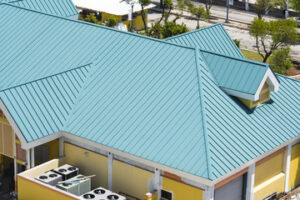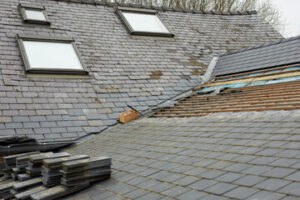Roof maintenance keeps the rafters, walls and foundation of your home safe and extends the lifespan of roofing materials. Regular inspections and prompt repairs help prevent minor problems from becoming major headaches later on.

Sitting debris like leaves, sticks and moss blocks rainwater drainage and damages the shingles beneath. Regularly cleaning gutters and removing overhanging tree branches prevent blockages. Visit their Site for more details.
A healthy roof is a key component of the overall integrity of your home. It protects your living space from harsh environmental conditions, boosts curb appeal, and contributes to energy efficiency. It also safeguards your investment in the property, preserving its value over time. Achieving all these benefits, however, requires a proper maintenance routine. That includes sealing, restoring and rejuvenating your roof shingles.
Shingles are a critical shield between your living spaces and the erratic weather in Tampa, FL. They provide a strong barrier against water infiltration, UV damage, and deterioration from temperature fluctuations. Moreover, a well-maintained roof reflects sunlight and provides insulation, further enhancing the energy efficiency of your home.
Asphalt shingle roofing offers a cost-effective alternative to other types of roofs and can last up to 20 years when properly maintained. These durable roofing materials are available in a variety of colors, styles, and textures to complement your home’s aesthetic. They are also renowned for their resistance to stains, mold, and mildew.
Regularly inspect your shingles to identify damage or deterioration. Addressing such issues promptly prevents water leaks and other related problems. In addition, replace any brittle or curling shingles. You should also check the flashings (metal or other material used to seal joints and transitions) around chimneys, vents, and valleys for signs of wear and tear.
Additionally, examine the interior of your home for any stains or discoloration. Any such indications may indicate a roof leak even if the stain is not directly above the source of the problem.
If you’re not comfortable conducting a visual inspection from the ground, hire a professional roofer to assess your roof. A reputable roofing company will be able to conduct repairs, replace damaged shingles, and ensure that your gutters are free of debris to promote effective drainage. Additionally, they can trim overhanging branches that may fall on the shingles during storms. This reduces the risk of further shingle damage and enables you to enjoy your home’s full functionality for a long time to come.
Flashing
Most homeowners would agree that they don’t enjoy the sudden appearance of a leaky roof. They might also agree that the structural integrity of a home should be protected from such damage, but there’s one specific element that helps ensure this: roof flashing. It’s a little-understood piece of the roofing system, but it’s an essential component that can save homeowners from a lot of money and headaches down the road.
A roof is a complex structure that’s designed to protect buildings from harsh weather conditions. However, even a properly installed roof can be compromised by small crevices that are left exposed as structures like vents, chimneys, and skylights are installed. Roof flashing is a thin sheet of metal that prevents water from entering these vulnerable points in a building’s exterior.
It’s often made of aluminum, which is both lightweight and durable. It can easily be bent to fit the curves of a roof, and it doesn’t rust when exposed to water or salty air. It’s commonly installed in places where the edges of a roof meet walls, dormers, and other parts of a building. It can also be used to protect electrical wires that run through a building’s exterior.
As such, it’s an important part of the roof that should be inspected on a regular basis. During these inspections, look for signs that flashing is in need of repair. Some of these include visible rust or corrosion, cracks, and holes in the flashing. These are all serious issues that should be addressed immediately, before they can spread and cause significant damage to a roof or the interior of a building.
The best way to prevent these issues is to work with a professional roofer when performing any type of roof maintenance. An expert roofer will know what to look for, and they’ll be able to advise you on when it’s time to replace your flashing. They can also recommend other types of roof maintenance that will keep your flashing strong and effective for years to come.
Gutters
Gutters serve a vital function in the preservation of your roof and home. By efficiently channeling water away from the roof, gutters help prevent rot, leaks, structural damage, and pest infestation. Additionally, gutters help to preserve the lifespan of roofing materials. Regular cleaning, professional inspections, and timely repairs or replacements are all key to maintaining a functional and durable gutter system.
Without functioning gutters, rainwater pours straight off the roof and pools near the house, causing leaks, mold growth, and foundation damage. Gutters are designed to catch and redirect rainwater, preventing it from overflowing and damaging the roof. They also prevent erosion and settling problems around the foundation of the house.
Clogged gutters prevent proper drainage and can lead to costly damage to the roof, siding, foundation, and landscaping. Gutters can be clogged with leaves, twigs, or debris, obstructing the flow of water. Overflowing water can cause shingles to wear down and erode, causing leaks in the interior of the house. It can also cause moisture to seep under the shingles, affecting the insulation and causing mold or mildew growth.
Gutters that are sagging or pulling away from the roofline may have accumulated too much debris or be improperly installed. These issues should be addressed immediately to protect the integrity of the roof and prevent costly repairs in the future.
While a complete roof and gutter system is an ideal solution for water management, it is not always possible to replace both components simultaneously due to budget constraints. It is important to prioritize and address the most urgent issue first, and then schedule regular inspections with a roofing expert. In the event that you need to replace your gutters, it is best to coordinate with a roofing company that can provide both services together. Combined work will minimize labor costs and ensure that the gutters are properly aligned with the roofline for maximum efficiency. They can also make sure that downspout extensions are in place to carry the water away from your foundation and landscaping. If you have any questions about addressing a specific roof or gutter issue, contact your local roofing experts for a free consultation.
Interior Stains
When homeowners think of keeping their homes clean, they often focus on vacuuming floors, scrubbing bathrooms, and wiping down kitchen counters. But a well-maintained roof plays an important role in keeping indoor living areas clean by preventing moisture and pests from infiltrating the home.
Water stains on the ceiling and walls are an indication that a roof is in need of maintenance or repair. This can be caused by many different factors, ranging from a leaking chimney flashing to age-related deterioration of the roofing membrane. Addressing leaks promptly minimizes the likelihood of interior damage and mold growth.
Other signs of a failing roof include cracks and blistering, elevated energy bills due to poor insulation, and excessive moss or algae growth. Ponding water and an accumulation of shingle granules in gutters are also warnings.
A professional inspection can identify potential problems that may be difficult for the untrained eye to notice. A skilled inspector will look at the entire roof surface, inspecting the shingles for discoloration or cracks, as well as looking for missing granules and other indicators of shingle wear. The inspection will also examine the flashings, checking for deterioration and proper installation. It will also check for leaky ridge vents and downspouts, as well as the condition of the soffit and fascia boards.
A professional roof cleaning can eliminate stains and other buildups that inhibit the function of the roof. Routine cleaning removes fungus, mold, and debris such as leaves, twigs, and moss that trap moisture, which can cause rot and deterioration of the shingles and structural components of the building. Additionally, a clean roof is more reflective and can help lower cooling costs.

